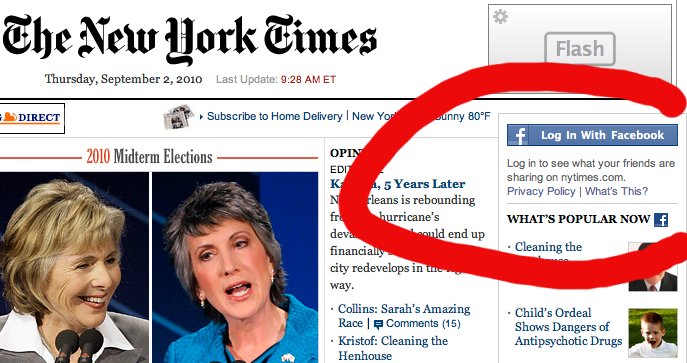I was surprised at how many people were interested in my recent post on Defending your privacy on the Web. When I posted it, I was afraid that it might be too long and too technical and thus too boring. But in addition to the comments on the blog, I had a number of responses in private email. So I will continue to think about privacy issues and how to get around Big Brother’s spying eyes on the web.
The Washington Post signed up to share data with Facebook several weeks ago. Now I’m appalled to see that the New York Times also is in cahoots with Facebook. Think how nice it is for advertisers if your Facebook data can be used at places like the New York Times to target you with advertising. Facebook knows your real name, who your friends are, what you like and dislike, etc. Targeting ads is not in itself offensive. The problem is having all this information falling into the hands of corporate America, which will use it to build dossiers, including your name, on individual Americans. These dossiers can be sold to whoever is interested — like potential employers, or the government.
How can you avoid this?
The first Facebook rule is this: Never, if you value your privacy, sign in with your Facebook ID to any sites other than Facebook.
Second, punish nosy, intrusive web sites such as the New York Times and the Washington Post by creating anonymous new logins. Here’s how.
1. Go to www.random.org and generate a random string for your sign-in ID, something like “RtAgr4MN”. Why a random string? It’s not necessary, but it’s a nice touch, and it gets you thinking about how randomness protects your privacy. Random data, by definition, contains no information at all.
2. Register at the site with your new sign-in ID, and give a fake (but workable) email address at www.mailinator.com. Your email name at mailinator.com can be the random string you generated in step 1 above. When the New York Times registration page asks you demographic questions about your age, etc., just make something up.
3. So that you won’t forget your new sign-in ID, edit the name of your bookmark to the site so that the bookmark name includes your sign-in ID.
4. For an extra level of anonymity, do Step 2 using Tor, the Onion Router. If you don’t yet know what Tor is, do some reading on the Tor web site. Tor is actually very easy to install and configure. Tor is much like a single-hop proxy server such as proxify.com, except that Tor uses multiple hops to hide your real IP address. Tor also is a free, open-source system. That is, corporations don’t own Tor.
I’m assuming that you’re already using the privacy steps I outlined in my previous post on privacy and that, when you sign in to a data-collecting site such as Facebook, you do so only in a separate browser. And of course it isn’t just Facebook we have to watch out for. It’s any of the sites whose revenue model is based on collecting, and reselling, personal data on its users. This includes Google and Yahoo, but the riskiest sites are the “social networking” sites such as Facebook and Twitter, which are clearly making a big push to get themselves enmeshed with popular web sites such as the New York Times.
As much as we might like Facebook, remember that it makes its money by collecting and selling information about you. As for Twitter, as far as I’m concerned it’s completely useless, and I have no idea why anyone goes there. But Twitter was developed, of course, to profit off snooping just as Facebook does.

Post a Comment